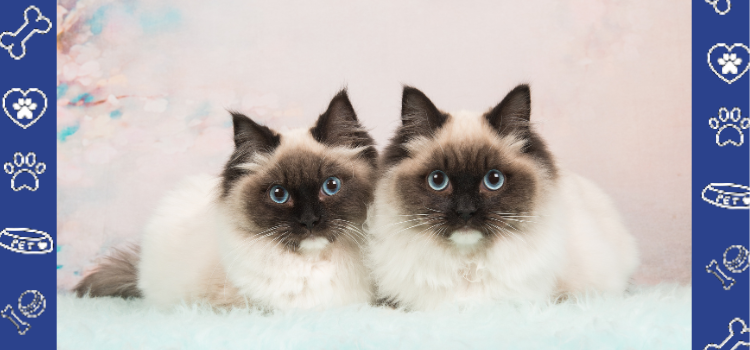How to Train Your Ragdoll Cat ...

How to Train Your Ragdoll Cat for Emotional Support Tasks
Emotional support animals (ESAs) have become an essential part of many people's lives, offering comfort, companionship, and a sense of security. Among the most loving and affectionate of breeds, Ragdoll cats are particularly well-suited for this role. Known for their gentle temperament and calm demeanor, Ragdolls can provide emotional support in a way that is both healing and reassuring.
If you're considering training your Ragdoll cat to assist with emotional support tasks, this guide will walk you through the process while highlighting how an ESA housing letter from PetCerts.com can make your journey even smoother.
Why Ragdoll Cats Make Great Emotional Support Animals
Ragdoll cats are a favorite choice for those seeking emotional support because of their affectionate nature. They are known for their "floppy" behavior, often going limp when picked up, which is a sign of their relaxed temperament. They tend to follow their owners around, sit on laps, and enjoy cuddling, all of which are comforting actions for someone who might experience anxiety or emotional distress.
Their friendly disposition and willingness to bond with their human companions make Ragdolls excellent candidates for emotional support roles. Their calm demeanor helps create a sense of stability, and their presence can reduce feelings of loneliness and stress.
Key Steps to Training Your Ragdoll Cat for Emotional Support Tasks
Training your Ragdoll cat for emotional support tasks may require patience, consistency, and a gentle approach. Here are some basic steps to guide you:
1. Build Trust and Comfort
The first step in training your Ragdoll cat for emotional support is to build a strong bond with them. Ragdolls are already predisposed to trust and affection, but spending quality time together will deepen your relationship. Sit with your cat, pet them, and speak in a calm, soothing voice. The more your cat feels comfortable around you, the more responsive they'll be to emotional support cues.
2. Introduce Basic Commands
Ragdoll cats can learn basic commands just like dogs, and it’s important to begin with simple instructions that can aid in emotional support tasks. Use treats, affection, and positive reinforcement to encourage behaviors like:
- Sit: Having your cat sit calmly beside you can be a grounding exercise during moments of anxiety.
- Come: Teach your cat to approach you when called, helping them provide comfort when needed.
- Cuddle: Ragdolls naturally love to snuggle, but teaching them to specifically approach and settle on your lap or near you when you’re feeling down can help them respond to emotional cues.
3. Train for Specific Emotional Support Tasks
Once your cat is comfortable with basic commands, you can work on more specific emotional support tasks. For example, teaching your Ragdoll to recognize when you're feeling overwhelmed can be achieved by pairing certain emotional states with specific actions, like:
- Purring for Comfort: You can encourage your Ragdoll to curl up and purr when you’re feeling anxious. Over time, your cat will learn that their presence has a calming effect on you.
- Physical Contact: Sometimes, simply having your cat rest on your lap or by your side can have an emotional stabilizing effect. Your Ragdoll’s natural affection can help to reduce feelings of isolation and stress.
4. Consistency and Positive Reinforcement
As with any animal training, consistency is key. Use positive reinforcement (such as treats, affection, or playtime) whenever your cat performs the desired emotional support behavior. With time, your Ragdoll will learn to recognize when you need them most and respond accordingly.
How a PetCerts.com ESA Housing Letter Can Help
While training your Ragdoll cat for emotional support tasks is important, securing the right to have your cat live with you can be just as crucial. If you're living in a rental property, a PetCerts.com ESA housing letter can help you navigate housing regulations that might otherwise restrict pets.
An ESA housing letter confirms that your Ragdoll cat is recognized as an emotional support animal, allowing you to live with your cat even in no-pets housing. This letter is a valuable resource for anyone who relies on their cat for emotional well-being, providing peace of mind knowing that you're legally entitled to live with your support animal.
PetCerts.com offers a quick and easy process to obtain an ESA housing letter from licensed healthcare professionals. The letter allows you to bypass pet restrictions and ensure that your Ragdoll cat can remain with you wherever you go, which is essential for your emotional support needs.
Benefits of Having a Ragdoll Cat as Your ESA
Ragdoll cats offer an array of benefits when it comes to emotional support, including:
- Calming Presence: Their affectionate and relaxed demeanor can help reduce anxiety and stress.
- Companionship: Ragdolls are highly social and love to bond with their owners, helping to alleviate feelings of loneliness.
- Emotional Stability: Their presence can help stabilize emotions, offering comfort during difficult times.
- Increased Sense of Security: The unconditional love and affection from your Ragdoll cat can provide a sense of safety, boosting emotional well-being.
Training your Ragdoll cat to provide emotional support can significantly enhance your quality of life. By investing time in building trust, teaching basic commands, and guiding your cat through specific tasks, you can ensure that your furry friend will be there when you need them the most. With an ESA housing letter from PetCerts.com, you’ll also have the legal protection to live with your beloved companion in rental housing.
Your Ragdoll cat can become more than just a pet; they can be a source of emotional comfort, offering unconditional love and support when you need it the most.